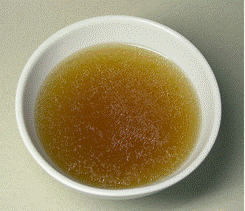Bone broth is prepared in cultures around the world. It is an easily digested medicinal food. The prolonged cooking of the bones in water, with an added acid (vinegar), draws the minerals out of the bone. This process creates a broth that is rich in nutritional constituents. It promotes strength, tones the blood, is nourishing during illness, supports bone health (we use this recipe at my clinic). This broth is also a wonderful addition to your detox program.
Choosing bones and flavorful ingredients The bones and cartilage of most meats can be used, including poultry, beef, lamb or fish (not pork). Choose bones from organic meats, and natural, grass-fed beef, with the fat and most of the meat trimmed off.
Chicken carcass is a good choice as it has a high concentration of red marrow. Beef and lamb bones give a nicer broth if they have been roasted in the oven first, until browned (400 degrees F or 200 degrees C for 45-90 minutes). If possible, use kitchen scissors to break the bones into smaller pieces, ideally 2-3 inches long, increasing the surface area of bone exposed to the boiling water therefore increasing the quality and nutrient value of the soup. For larger bones, your supermarket butcher will usually cut them for you.
Place the bones in a stockpot and just cover with cold water. Add a “splash”, or about 2 tablespoons, of rice, wine, cider, or balsamic vinegar per quart of water or per about 2 pounds of bones. An acid such as vinegar is necessary in order to extract the minerals and nutrients from the bone into the soup. Lemon juice may be substituted for the vinegar. Garlic, onions and ginger may be added for increased flavor, as well as coarsely chopped pieces of celery, carrot, parsley and other vegetables.
COOKING AND STORING THE BROTH
Heat the stock very slowly, gradually bringing to a boil, then turn heat down and simmer for at least 6 hours, removing the scum as it arises. 6 – 48 hours is an ideal cooking time for chicken bones and 12 – 72 hours for beef. If the bones are cut into smaller pieces first, this will reduce the necessary cooking time. You do not want to rapidly boil these. If more water is needed to keep the bones covered, add only hot water, not cold or lukewarm.
Cooking in a crockpot on low setting is an easy way to cook broth for a prolonged time. Though it is not necessary to remove the surface scum that arises, doing so occasionally during the cooking process will result in a nicer tasting broth.
After simmering the bones for several hours, other vegetables may be added for the last 1-2 hours of cooking. This adds to both the flavor and nutritional value of the broth. When finished cooking, the bones and vegetables can be removed and discarded, and the liquid strained through a colander. For a clear soup, it should be strained a second time through a hair sieve or a colander lined with cheesecloth. Parboiling and rinsing the bones before cooking and cooking on a low heat can also help produce a clear broth as it greatly reduces the amount of residue in the liquid. For the purpose of this program, you do not need to have a perfectly clear broth. Simply skim the scum that arises, remove the bones and strain the vegetables and remaining bones/ meat pieces.
The broth should be set to cool until the fat hardens on top, then remove the fat and refrigerate the broth. It will keep for about 5 days in the refrigerator, or 10 days if it is boiled again in 5 days, and can be kept for months in the freezer. Before re-heating, always remove and discard any residual fat from the top. Properly prepared broth will cool to a rubbery, jellylike consistency due to the high gelatin content of the collagen. It can be re-heated and used as a simple nutritious drink, or for a more complex soup, add steamed or sautéed vegetables, meat, and/or beans.

